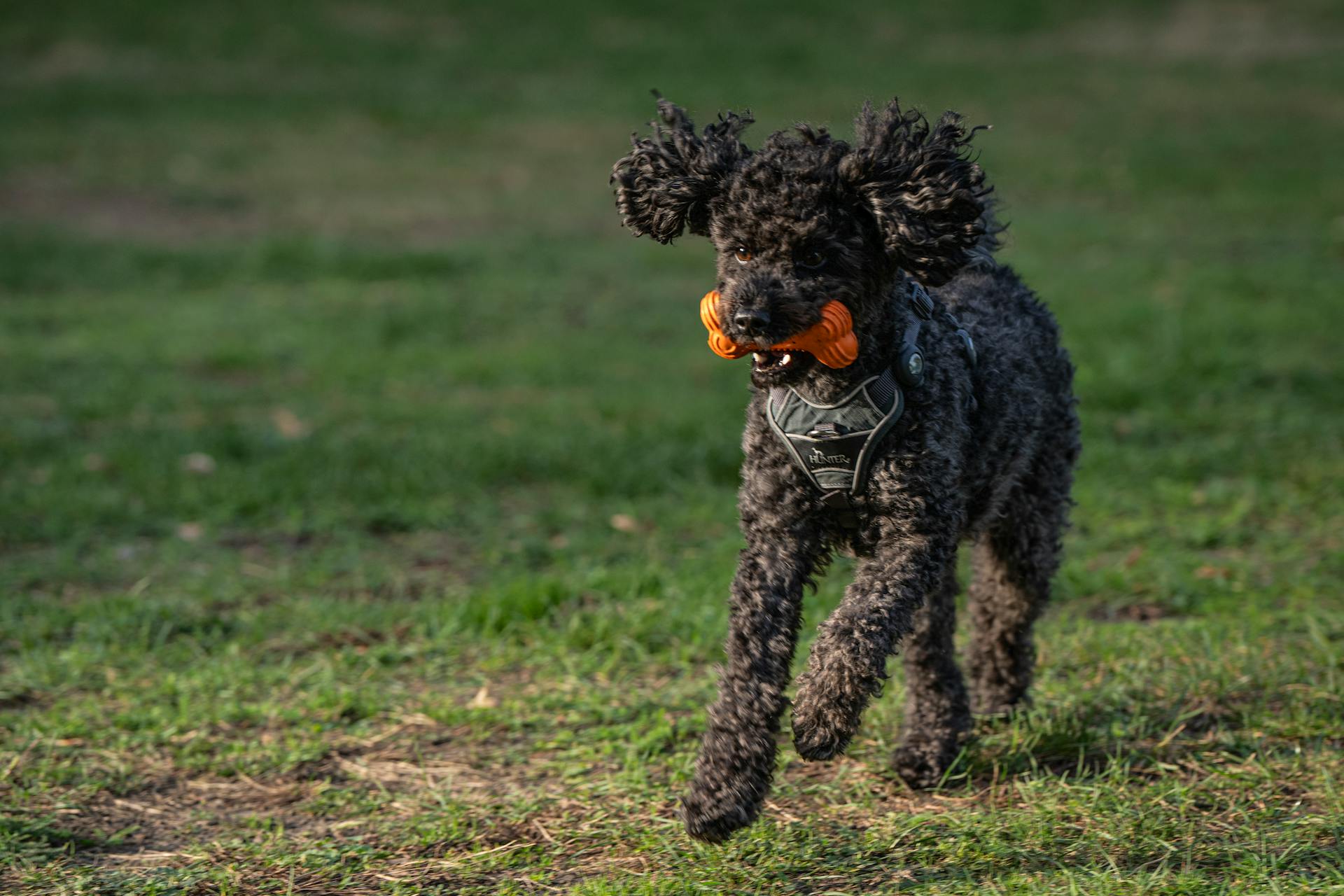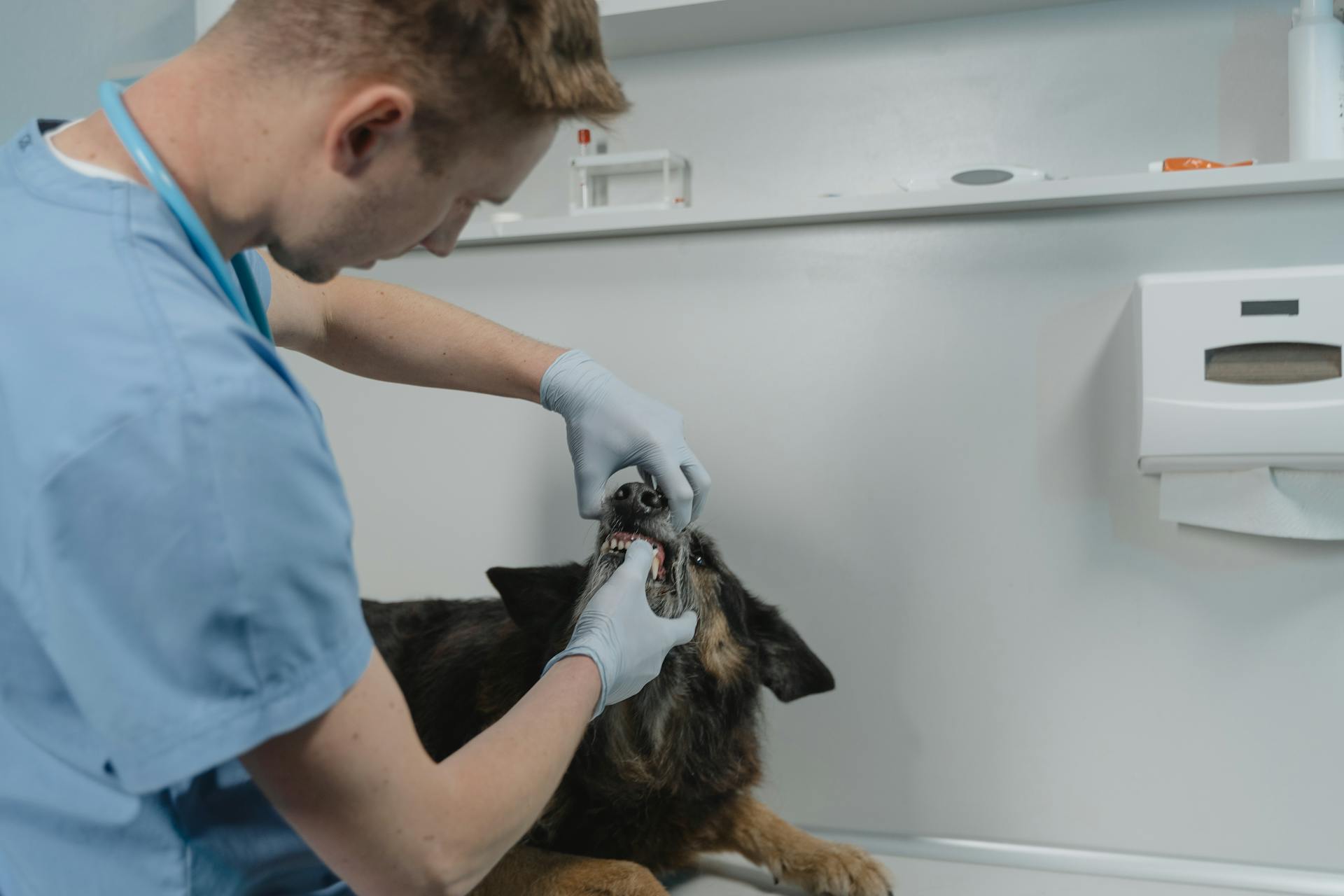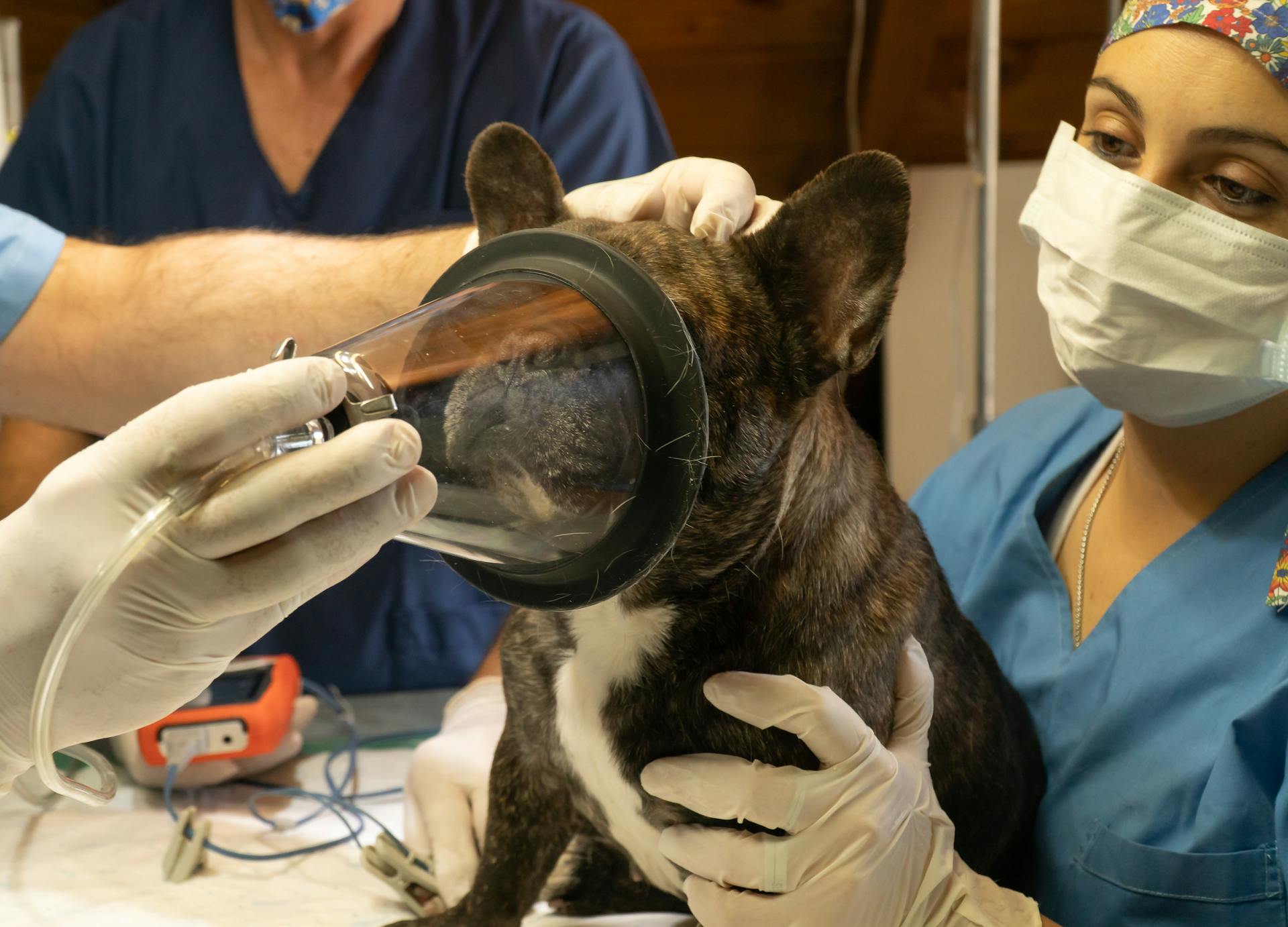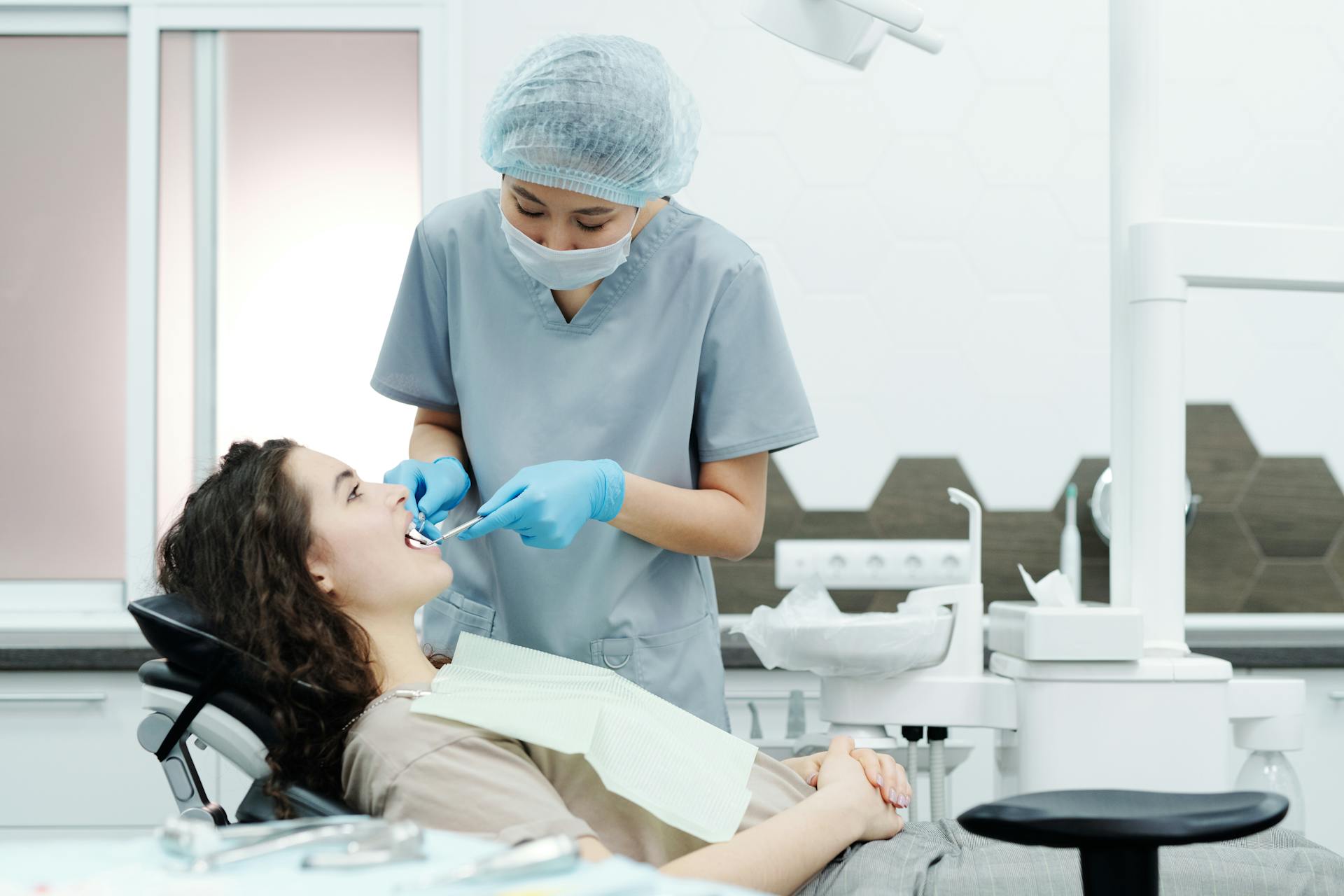
Maintaining your dog's dental health is crucial for their overall well-being. Bacteria in the mouth can lead to serious health issues, such as kidney disease and heart disease.
Regular dental care can prevent these problems. Brushing your dog's teeth daily is essential, but it's not always easy. Many dogs are not fond of having their teeth brushed, but it's a vital part of their oral health.
Some dogs are more prone to dental issues than others. For example, small breeds, such as Chihuahuas and Poodles, are more susceptible to tooth decay and gum disease.
Expand your knowledge: Homemade Food for Dogs with No Teeth
Importance of Dog Dental Care
Oral health plays a critical role in your pet's overall wellness, just like it does for humans. Regular dental care is essential to prevent dental health issues in dogs.
Maintaining a healthy mouth for your dog is a top priority, so it's crucial to schedule a professional cleaning with your veterinarian annually or as recommended. This will help catch any potential problems early on.
Regular brushings are a simple and effective way to keep your pet's teeth and gums healthy. Use pet toothpaste, never human toothpaste, which can be unsafe for your dog.
A dry food dental diet and dental chews are additional ways to help keep teeth clean and avoid tartar buildup, keeping your pet happy and healthy.
Explore further: Heart Healthy Food for Dogs
Causes of Dog Dental Problems
Periodontist bacteria can enter your dog's oral cavities, leading to chronic pain, tooth loss, and infection that can spread throughout the body.
Gum disease is caused by the accumulation of bacteria at the gum line due to a lack of proper oral hygiene, and other contributing factors may include breed, genetics, age, and diet.
Bacterial infection of the tissue surrounding the teeth causes inflammation of the gums, the ligaments that anchor the teeth, and the surrounding bone, which can ultimately lead to tooth loss if left untreated.
The buildup of bacterial waste products, such as hydrogen sulfide, ammonia, acids, and other compounds, can damage tissues and cause tissue breakdown and loss of the tooth's supporting tissues.
Daily brushing, dental treats, and routine cleanings are the best ways to prevent tooth loss that can cause pain and challenges for pets on dry food diets.
On a similar theme: Veterinary Oral Health Council Dog
Organ Damage
Maintaining daily teeth health is essential to prevent bacteria from entering your dog's bloodstream.
Bacteria and infection can spread through your dog's body, leading to severe organ damage.
If left unchecked, this can contribute to or cause heart disease.
Liver disease is another potential consequence of poor dental health.
Kidney disease can also be a result of bacteria and infection spreading through the body.
Keeping your dog's mouth healthy plays a meaningful role in their overall wellness.
Periodontal Disease
Bacteria from buildup on teeth can enter your dog's bloodstream, leading to severe organ damage and diseases like heart, liver, and kidney disease.
Gum disease is a major reason for tooth loss in dogs, caused by the accumulation of bacteria at the gum line due to a lack of proper oral hygiene.
Gingivitis, a form of gum disease, can be treated with thorough professional cleaning of the teeth, but if it doesn't improve, your veterinarian may need to perform more extensive cleaning.
If your dog has started losing adult teeth, it's a good reason to check with your vet, as it can be a sign of oral disease or injury.
Daily brushing, dental treats, and routine cleanings are essential to prevent tooth loss and gum disease, which can cause pain and challenges for pets on dry food diets.
Bacterial infection of the tissue surrounding the teeth causes inflammation of the gums, ligaments, and surrounding bone, leading to the loss of teeth if left untreated.
Gum disease is caused by the accumulation of bacteria at the gum line, and as the number of bacteria increases, bacterial waste products damage tissues and cause inflammation.
Dogs that don't respond to treatment for gingivitis may have underlying conditions like immune system problems or diabetes, and should be evaluated by your veterinarian.
Enamel Defects
Enamel defects can be a real problem for dogs, especially if they're not caught early.
Fever-causing diseases, such as the canine distemper virus, can attack the enamel-producing cells of the teeth, causing the enamel to be thinner than normal.
Malnutrition in young dogs can also lead to enamel defects, making their teeth weaker and more prone to problems.
Trauma or infection can cause enamel defects in isolated teeth, often affecting the enamel of the permanent teeth that come in behind them.
Enamel defects can also be inherited, especially in Siberian Huskies, which can make them more susceptible to dental problems.
In some cases, enamel defects can be treated with bonding of synthetic materials to the teeth, fluoride treatment, and frequent dental preventive care.
Prevention and Maintenance
Preventing tooth loss is crucial for your dog's quality of life. Daily brushing, dental treats, and routine cleanings are the best ways to prevent tooth loss that can cause pain and challenges for pets on dry food diets.
Regular dental examinations are essential to catch any potential issues early on. If your dog has started losing adult teeth, it's a good reason to check with your vet.
Maintaining a healthy mouth for your dog is a top priority, so what can you do to avoid dental health issues? The two best ways are to maintain routine dental care at home and schedule a professional cleaning with your veterinarian annually or as recommended.
Proper Care

Daily toothbrushing is best for maintaining your pet's oral health, but wiping the teeth with a gauze at least every 2–3 days can also be effective, especially for dogs that don't tolerate toothbrushing.
The Veterinary Oral Health Council (VOHC) recommends using only pet-specific toothpaste, as human toothpaste contains toxic ingredients like xylitol and fluoride.
Dog dental wipes are a great alternative to toothbrushing, and can be used to remove plaque from your dog's teeth.
Maintaining a healthy mouth for your dog is a top priority, and regular brushings, using pet toothpaste, can help prevent dental health issues.
A dry food dental diet and dental chews are also ways to help keep teeth clean and avoid tartar buildup.
You'll need a dog toothbrush and dog toothpaste specifically designed for your dog's teeth, as human toothpaste is not safe for them.
Dog dental powders contain a probiotic that helps boost healthy bacteria in your dog's mouth, killing plaque-building bacteria and preventing tartar and plaque buildup.

Here are some steps to get your dog used to toothbrushing:
- Touch the teeth and gums without the brush.
- Touch the toothbrush to the teeth.
- Introduce the toothpaste to the dog.
- Add the toothpaste to the toothbrush.
- Start brushing the top teeth.
- Move from the front teeth further back to the side and back teeth on the top.
- Start brushing the bottom teeth.
- On the bottom teeth, now brush the sides and back.
Remember to praise and reward your dog for tolerating toothbrushing, as it's an unnatural process for them.
Your veterinarian may perform preanesthetic blood tests to ensure your dog's safety before a dental cleaning, and will review with you what procedures are likely required prior to the dental cleaning.
Chew Toys
Chew toys are a great way to keep your dog happy and healthy. They help satisfy your dog's natural instinct to chew and keep them occupied.
Daily gnawing on chew toys scrapes plaque off your dog's teeth, which is a key part of oral health. Providing dogs with a variety of chew toys keeps them interested and stimulated.
There are many types of chew toys available, including rubber, nylon, and rawhide. Rotating different types of chew toys is a good idea to keep your dog engaged.
Chew toys don't have to be expensive or calorie-rich, as there are many long-lasting rubber or nylon options available. These are a great choice for dogs on a diet.
By providing your dog with chew toys, you can help improve their oral health and keep them happy and entertained.
Take a look at this: Great Dane Dog Health Problems
Brushing and Cleaning
Brushing your dog's teeth is an excellent way to prevent plaque buildup, and you don't need to do it daily, although the more often the better. Most dogs aren't too fond of it at first, but you can easily train your dog to have his teeth brushed the same way you would to have his nails trimmed.
You'll want to get toothpaste made specifically for dogs, as human toothpaste contains toxic ingredients like xylitol and fluoride that could cause significant harm. Dog toothpaste comes in many appealing flavors like peanut butter, beef, and chicken.
To brush your dog's teeth, you can use a dog toothbrush or a brush that fits over your fingertip. Ask your veterinarian about what's best, and see what you and your dog prefer. Brushing should be on every dog owner's daily agenda, as it's very important for your dog's oral health.
Here are the steps to get your dog used to toothbrushing:
- Touch the teeth and gums without the brush to get your dog accustomed to having his mouth handled.
- Introduce the toothpaste to the dog by letting them lick it from your finger.
- Add the toothpaste to the toothbrush and start brushing the top teeth.
- Move from the front teeth further back to the side and back teeth on the top.
- Brush the bottom teeth, starting with the front teeth, then moving to the side and back.
- Praise and reward your dog frequently to make the experience positive.
Dog dental wipes are a great solution for those who are unable to brush teeth or simply want to switch up their cleaning techniques. They work similarly to toothbrushes, but are not able to get into the tiny nooks and crannies that a brush does.
You should brush your dog's teeth at least once a week, but ideally every day, to prevent tartar accumulation. A home dental care program including regular tooth brushing is a must to prevent plaque and tartar from forming.
Frequently Asked Questions
What are the 4 stages of dog dental disease?
Dog dental disease progresses through 4 stages: initial tartar buildup, swollen gums and bone loss, continued bone loss, and severe bone loss leading to tooth loss and gum damage
What do vets recommend for dogs' teeth?
Vets recommend enzymatic dog toothpaste and a suitable brush or rubber thimble to keep your dog's teeth clean and healthy. Enzymatic toothpaste is a safe and effective option that comes in tasty flavors like chicken or liver.
Sources
- https://metrovetclinic.com/resources/dental-health-in-dogs/
- https://www.akc.org/expert-advice/health/keep-dog-teeth-clean/
- https://www.merckvetmanual.com/dog-owners/digestive-disorders-of-dogs/dental-disorders-of-dogs
- https://www.akc.org/expert-advice/health/how-brush-dog-teeth/
- https://vcahospitals.com/know-your-pet/dental-cleaning-in-dogs
Featured Images: pexels.com


